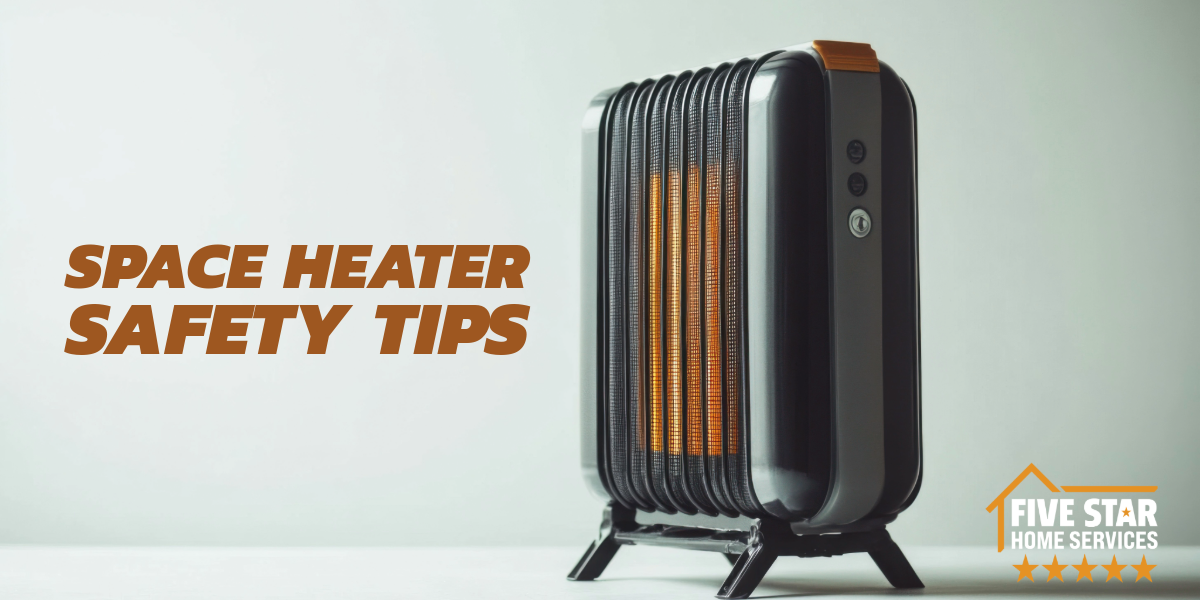A central heating system that delivers heat to multiple rooms or areas in your home is very welcome. Sometimes, though, you may need a little more heat in an area of the house where a draft or an occupant of the room feels colder than the rest of the household. You may also want to heat up one area of the house instead of your entire home. A space heater is a portable appliance that can provide the extra heat you need and is usually adequate in heating a small or medium-sized room. Therefore, space heaters are a go-to solution when you need to heat a relatively small space in your home immediately. Compared to a central heating system, they are inexpensive, convenient, and mostly energy-efficient. The flexibility of directly controlling the heat you immediately need during those times when you cannot wait for the whole house to warm up is a bonus.
What are the different types of space heaters?
Space heaters usually work either by radiant heating or by convection.
- Radiant heating affects objects and people that are in the direct flow of heat emission, which means that you will feel the heat directly from the appliance. It is targeted heat and is convenient for use in short amounts of time and when you are within range of the radiant heater.
- Convection heating delivers the heat into the circulating air and may take a while for the room to heat up. Thus, this is a good choice for a room that is going to be dependent on the heat for longer periods of time.
Space heaters are powered by electricity or combustion, such as propane and kerosene. It also matters whether the space heater you need can be used indoors or outdoors.
Indoor space heaters
- Ceramic—This is made up of ceramic plates that are heated via electricity. The heat is then either fan-forced and quickly heats up the room or radiates out, which may take a while.
- Infrared—This type of heater has a quartz element that generates electromagnetic waves to heat up whatever is in its direct path. Infrared provides instant heating, but heat does not linger as soon as the heater is powered down.
- Oil-filled – This heater contains oil that heats up when electricity passes through it. Once it is hot enough, the metal rods inside the heater also get hot, and the air is warmed up through convection. Because of this, the room keeps its warmth for a long time.
Outdoor space heaters
Heaters that run on carbon-based fuels are generally meant to be used outdoors where there is minimal danger of suffocating on fumes that they will most likely emit or be exposed to the by-product of incomplete combustion of gases (carbon monoxide). Nowadays, some heaters are specifically designed to be safe for indoor use with safety features (e.g., automatic power shut-off when knocked over). Still, it is highly recommended that natural gas heaters should be vented, i.e., attached to a chimney so that combustion products may be directed outdoors instead of in the heated space, thus maintaining indoor air quality.
- Propane heater—This runs on liquid propane (not electricity) and must be refilled. It is cost-effective but tends to produce vapors that can damage walls and surrounding furniture if ventilation is inadequate. Because of the bulk of the propane tanks, propane heaters are more difficult to move around.
- Kerosene heater—This uses kerosene instead of electricity. It does not burn as well as propane and has a short shelf life. It puts out more moisture than propane heaters, so proper ventilation is important. Kerosene is less accessible than propane, although kerosene heaters are much more portable.
- Patio heater—This is designed for outdoor use in open spaces. It stands out as a somewhat tall structure that runs using fuel from natural gas lines or propane tanks.
What safety features do space heaters have?
Safety considerations are important with space heaters. With most consumer products, safety standards are vouched for by independent testing laboratories. Two of the most recognized certifications are from the Underwriters Laboratories (UL) and Electrical Testing Laboratories (ETL), which indicate that they are certified to have passed standards of safety and dependability. At least look for these certification marks on your space heater first. Because they produce considerable heat very quickly, most space heaters are designed with fire-preventive measures and safety features such as:
- Automatic off function/ tip-over feature – The heater turns off immediately if it accidentally tips over or overheats. It is an important feature to also consider when you have children (or even pets), as they tend to get rambunctious and in moving around, they may knock over the space heater.
- GFCI plug – A ground fault circuit interrupter prevents the occurrence of electric shocks. A heater that does not have a GFCI outlet should not be used in the bathroom or in places that are wet or damp.
- Strong and durable cord – Most space heaters come equipped with a cord that is up to the task and of considerable length.
- Overheat detection/protection – The unit automatically shuts off when the internal temperatures get too high even for the heater itself. This feature not only protects the surrounding areas from catching fire, but also minimizes the risk of internal damage to the heater.
- Timer -This is a convenient safety feature, especially when you cannot attend to the heater constantly. It is helpful when you just want some warmth as you sleep through the night. You can set the amount of time that you will need for an area of the home heated, then the heater would just automatically shut off once the preset length of time has passed. It is recommended to preset a short time frame, even when some heaters are able to accommodate several hours of preset time.
- Non-metal surfaces (especially with children, pets) – Since metal is a conductor of heat, a heater that has surfaces made of metal may be dangerous if children or pets are around. Try to choose a heater that has minimal metallic parts to avoid accidental burns. Teach children to stay away from the heater.
What are some safety tips to keep in mind?
Space heaters and other heating appliances are the second leading causes of home fires in the US, accounting for subsequent property damage, personal injury, or even death. Remember that although space heaters are highly convenient sources of supplemental heat, taking the proper precautions when using them will significantly reduce the incidence of burns, fires, or electrical injuries. As you use your space heater, follow these tips to ensure a safe and warm environment for you:
- Let your space heater stand on an even, stable surface to minimize any risk of toppling over.
- Make sure that the heater is in an undisturbed area with less foot traffic
- Keep the heater away from materials or surroundings that are likely flammable. A good rule of thumb is about three feet away from materials such as curtains, furniture, bedding, etc. Be careful also of the heater being around gas cans or paint, such as in a garage.
- Bathrooms or other areas that may get wet are unsuitable for space heaters, so avoid having them in these places to decrease the risk of electric shock.
- Directly plug in your heater using the wall outlet without sharing the outlet with another device. This ensures that overheating does not occur. Avoid using extension cords. Your heater pulls more electricity than average, and extension cords will not support the electrical load.
- Unplug the heater when not used, and regularly check the cord for damage or fraying.
- Special precautions should be taken if you have children or pets in the home. Establish the three-foot rule with children, situate the space heater on higher (but level) ground if possible, and never leave the space heater unattended if children or pets are present. Avoid having space heaters in children’s rooms.
- Do not put anything on your space heater or use it to dry or warm clothes or any material.
- Your home should have smoke alarms on every floor and outside sleeping areas. Make sure to test that they are functioning properly every month or regularly. If your space heater is fueled by gas or it is not vented, you should also have carbon monoxide detectors in your home.
Space heaters are lovely and convenient appliances that help you keep warmer during times that you need that extra heat source. With a little bit of care and the implementation of safety measures, you can be sure that your space heater will provide you with the comfort you expect when you need it. For your home’s heating needs, you can also be sure that Five Star Home Services can provide expert advice. We do furnace maintenance, tune-ups, and a broad range of services to keep you comfortable during the cooler season. Contact our team of expert technicians and call Five Star Home Services now at (833) 405-8009.


